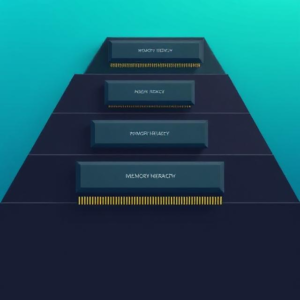What is Memory in Digital Systems?
In any digital system, like a computer or smartphone, memory is where data is stored. Memory allows the system to quickly access and process information.
Think of it like different levels of storage in a library:
- High-speed access (like a library’s front desk, where books are easy to grab)
- Lower-speed access (like books in the library’s shelves, which take a bit more time to find)
In digital systems, different types of memory work at different speeds, with some being much faster but smaller, and others being slower but much larger.

What is a Memory Hierarchy?
A memory hierarchy is the way different types of memory are arranged in a system, where faster, smaller types of memory are placed closer to the processor (the brain of the system), and slower, larger types of memory are placed further away. The idea is to combine fast, small memory with slow, large memory to get the best performance and efficiency.
Think of a pyramid:
- Top level: Fast, small memory (like cache).
- Bottom level: Slower, larger memory (like hard drives).
Why is Memory Hierarchy Important?
Memory hierarchies are crucial because:
- Speed vs. Size Tradeoff: Faster memory is usually smaller and more expensive, while larger memory is slower and cheaper. The memory hierarchy helps balance this tradeoff.
- Efficiency: The hierarchy ensures that the most commonly used data is stored in the fastest memory, improving system performance.
Levels of Memory in a Hierarchy
Let’s look at the typical levels of memory in a hierarchy, from fastest to slowest:
- Registers (fastest, smallest)
- What they are: These are tiny storage areas inside the processor itself. They store very small amounts of data that the processor needs immediately, like a number it’s currently working with.
- Why they are important: They are very fast, but there’s only a small amount of space in them (just enough for immediate data).
- Cache Memory
- What it is: Cache memory is a small, super-fast type of memory that stores frequently accessed data. There are usually multiple levels of cache:
- L1 Cache: The smallest and fastest, located directly inside the processor.
- L2 Cache: Larger than L1 but slower, located slightly further from the processor.
- L3 Cache: Larger and slower than L1 and L2, often shared between cores of a multi-core processor.
- Why it’s important: Cache helps speed up the processor by storing data that is used often, so it doesn’t need to fetch it from slower memory each time.
- What it is: Cache memory is a small, super-fast type of memory that stores frequently accessed data. There are usually multiple levels of cache:
- Main Memory (RAM – Random Access Memory)
- What it is: RAM is where programs and data that are currently being used by the computer are stored. It’s much larger than cache memory but slower.
- Why it’s important: RAM allows the system to work on large amounts of data, but since it’s slower than cache, the processor might need to wait for data to be fetched from RAM.
- Secondary Storage (Hard Drive, SSD – Solid State Drive)
- What it is: This is long-term storage where your files, programs, and the operating system are stored. Hard drives are slower, but SSDs are much faster than traditional hard drives.
- Why it’s important: This memory is huge compared to RAM, but it’s much slower. It’s where data is stored when not actively in use.
- Tertiary Storage (e.g., Optical Discs, Cloud Storage)
- What it is: Tertiary storage includes things like DVDs, Blu-ray discs, and cloud storage. These are very slow but have a lot of storage space.
- Why it’s important: These types of storage are used for backups or archival purposes. You don’t need them quickly, but they provide a lot of space for data.
The Tradeoff: Speed vs. Size
Here’s the main tradeoff:
- Faster memory is smaller and more expensive (like registers and cache).
- Slower memory is larger and cheaper (like hard drives or cloud storage).
How Does Memory Hierarchy Work in Practice?
- Processor requests data:
- The processor first checks the registers for the data. If it’s there, it’s super fast.
- If not in registers, check cache:
- If the data isn’t in the registers, the processor checks the cache memory (L1, L2, or L3). Since cache is fast but small, it often holds recently used or frequently accessed data.
- If not in cache, check RAM:
- If the data is not in the cache, the processor then looks in RAM, which is larger but slower. This is where most of the active data is stored.
- If not in RAM, check secondary storage:
- If the data is not in RAM, it might be in the hard drive or SSD. But accessing data here is slow, so it’s not ideal unless the data isn’t used frequently.
Example: Using a Computer
Let’s use an example of a computer running a program:
- The CPU first looks in its registers for the data it needs. If it’s not there, it checks the L1 Cache.
- If it’s still not found, it checks the L2 Cache and then L3 Cache.
- If the data isn’t in any of the caches, the system looks in RAM.
- If the data is not in RAM, it goes to the hard drive or SSD to find it, but this is the slowest step.
By using this system, the computer ensures that it uses the fastest available memory first, making everything run faster and more efficiently.
In Simple Terms:
- Memory hierarchy is like a layered approach to storing data in a computer, with faster but smaller types of memory at the top, and slower but larger types at the bottom.
- The goal is to keep the most used data in the fastest memory (like registers and cache) so the system can access it quickly.
- Registers are the fastest, cache is a bit slower but still fast, and RAM is slower than cache but bigger. Secondary storage like hard drives are the slowest but hold lots of data.
- This hierarchy helps balance speed and size, making the system as fast and efficient as possible.











